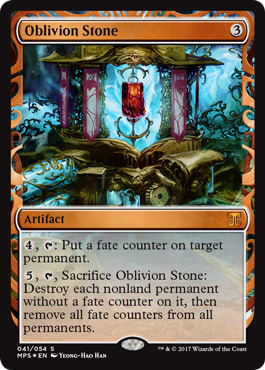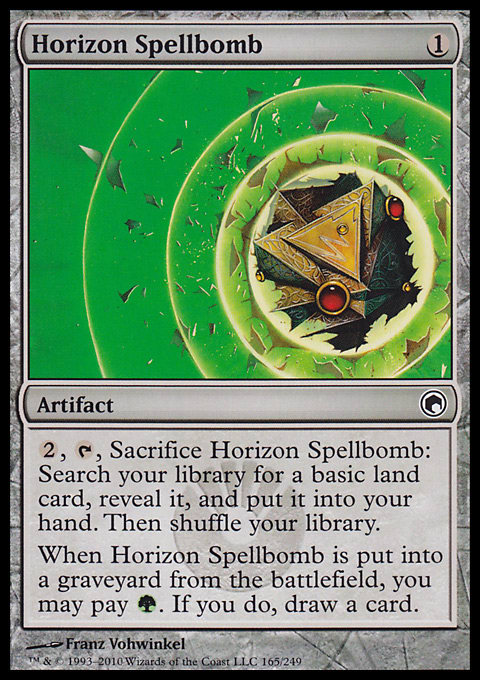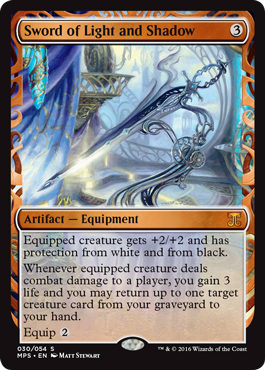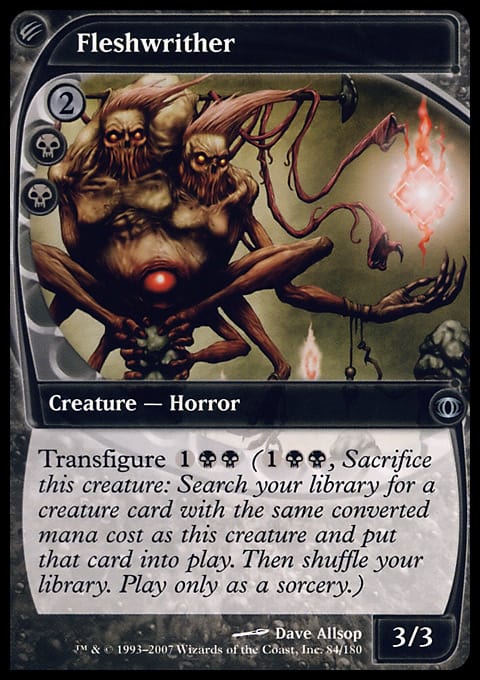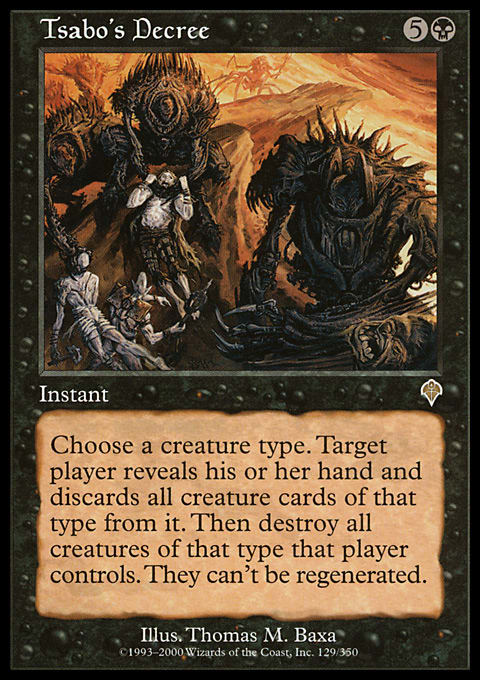My approach to building Commander decks is really very simple. If I were ever to boil it down for a new player, it would come down to two main principles:
- The perfect is the enemy of the good.
- It’s all about value.
The first is actually the most valuable piece of advice I received while working on my dissertation, but like all life lessons, it applies to Magic, too. Don’t worry about getting your deck just so—perfectly balanced, powered up, and pimped out1—just shuffle it up and play! You’ll have more fun playing a weak deck with your friends than fiddling with a work in progress alone in front of the TV, and you have all the time in the world to change it later. Sleeve it, shuffle it, and sort it out later; that’s what I say!
The second point, value, is also known as card advantage, and if there was ever something that defined my card selection, it’s this. Seriously, I never met a 187 creature I didn’t like; I even try to put recursion engines in my mono-red decks; and I’m always looking for something that will leave my opponents a little bit down and me a little bit up. Whether it’s Syphon Mind, Spinal Embrace, or the new Grave Exchange, I’m a sucker for value.
This week’s deck combines both of those approaches. I was intrigued by Glissa, the Traitor as soon as I saw her, but I had no idea what to do with her. I bought a play set on eBay right away, but she just sat there without a home while work distracted me. After a month, I just threw together some random black, green, and artifact cards, and a pile of 100 sleeves, and when I ran out of sleeves, I called the deck finished. Like I said: Start playing now, and sort it out later!
Today, I’m going to revisit that first draft of Glissa, the Traitor and finally set up a more coherent, focused, and streamlined version of the deck—based on The Rock.

Not this one.

Or this one.
Concept
The Rock is a major tournament-deck archetype that dates back to Invasion block (around 2000). It was a midrange deck, originally B/G, that won through board control and grinding attrition; in other words: value! Considering Glissa is already in the right colors and is a recursion engine in her own right, I wanted to make this deck the ultimate in value. Everything blows something up! Everything comes back! Everything generates value! In fact, I don’t want a single card in here unless it gives me a two-for-one . . . at least!
Brainstorming
To begin with, I’m going to gut the original build, keeping a handful of perennial all-stars and up-and-coming rookies. Of my original sixty nonland cards, there were thirty-six that might make the cut, and they’ll at least serve as a rough skeleton to the updated version. Curiously, the two most obvious cards to use with Glissa—Nevinyrral's Disk and Oblivion Stone—were missing from my first draft because I didn’t have any spare, but that’s what happens when you accept that the perfect is the enemy of the good. If I waited until I had both of those sweepers before I built a deck, I’d only have about four decks; on the other hand, learning to build and play without those staples/crutches has its advantages, like trying out the underplayed Pithing Needle and the fun Plague Boiler.
The kinds of cards I’m going to look at include:
- Disposable artifacts – Jester's Cap and Executioner's Capsule are the heavy hitters, but there’s loads of fun to be had with things such as Expedition Map, Armillary Sphere, Tormod's Crypt, (definitely not Relic of Progenitus) and more Baubles (Wayfarer’s, Urza’s, and Conjurer’s).
- 187 critters – Bone Shredder, Big Game Hunter, Viridian Shaman, Uktabi Orangutan, Woodfall Primus, and Terrastodon. No surprises here; they’re commonly played because they’re really damned good. Don’t leave home without ’em!
- Cockroaches – Undying creatures, Zeniths, and Beacons, Ob Nixilis, and Dust Bowl (a tribute to the original The Rock deck). With Tree of Tales and Vault of Whispers to sacrifice to it, I could have a lot more options for dealing with troublesome lands than most decks. I’m also interested in finding a home for my newly acquired Griselbrand and Harvester of Souls.
- Spells with multiple targets – Stomp and Howl, Relic Crush, and my new favorite three-for-one, Rain of Thorns are great, but there’s also Ashes to Ashes, Dead Ringers, Hibernation's End. Also, ramp effects like Cultivate and Kodama's Reach and sweepers of various kinds fit the bill.
The Gathering
Thinking about how Glissa really works, I’ve realized that she presents two unique challenges. The first challenge when building around her is of course how far to go with the artifact theme. A bunch of those cute little baubles and spellbombs and so on (they were nicknamed “cogs” in Mirrodin block) can help in the early game, and it’s great if you can recur them aggressively, but they make lousy top-decks. In fact, the best thing about the cantrippy cogs that I’m favoring for this build is that they give you multiple chances to draw into other spells. That obviously means that achieving a good balance of cogs and more powerful spells is crucial.
The second unique challenge that Glissa presents is her scalability. The number of artifacts you can recur is never more than the number of opponents’ creatures that bite the big one, which is more or less proportionate to that number of opponents you’re facing. You never want to be playing Glissa in a duel or three-way; instead, she’s probably only going to shine in a game with four or more players. You can try to maximize this by putting in plenty of kill spells, but at the end of the day, you’re limited by how many opponents you have.
Any deck designed for taking out multiple opponents is going to suffer in a duel, but none more so than Glissa. As a result, she’ll have to be saved for larger games or against decks with swarms of creatures to kill.
This time around, I didn’t have any set numbers in mind for the different classes of spells, so I’ll just tell you what cards made the cut and what notables didn’t. Here, I present the cards piecemeal, rather than in one unreadable chunk, with the deck name at the end.
Artifact Acceleration
"Glissa Rock"
- Artifact Acceleration (10)
- 1 Mishra's Bauble
- 1 Chromatic Star
- 1 Horizon Spellbomb
- 1 Terrarion
- 1 Wayfarer's Bauble
- 1 Ichor Wellspring
- 1 Mycosynth Wellspring
- 1 Prophetic Prism
- 1 Pilgrim's Eye
- 1 Solemn Simulacrum
Out: Expedition Map, Explosive Vegetation, Skyshroud Claim, Dreamstone Hedron
Let’s start with the artifacts. I have ten artifacts lined up for acceleration, which is unusual for a commander that's two-thirds green; normally, I’d use green’s natural strength for acceleration, but with Glissa, these artifacts, some of which are just also-rans, can become all-stars over the long game.
What was cut and why? Well, the Map is great if you’re running the expensive lands, but this deck doesn’t have them and doesn’t need them. The sorceries are also some of my favorite green spells, but over the long game, they aren’t going to be as good in this deck. With Glissa out, someone’s going to kill a creature, and you’ll be able to bring back something small and useful and cast it with spare mana, squeezing out a little more value each time.
That was also why Dreamstone Hedron didn’t make the cut despite being among my favorite cards. Even though it only costs 3 to cast in a sense and it can draw a ton of cards, it just seemed too slow in this deck. I really am relying on these cheap artifacts to power me into the mid- to late-game, and I will probably take advantage of the official Commander mulligan rule to get rid of most cards that aren't either land or accelerants.
In fact, the ability to cast a bunch of low-cost spells in a single turn made me consider storm spells, but black and green are pretty weak in this area, with Reaping the Graves being the only spell even worth considering.
Business Artifacts
"Glissa Rock"
- Business Artifacts (17)
- 1 Nihil Spellbomb
- 1 Pithing Needle
- 1 Ark of Blight
- 1 Executioner's Capsule
- 1 Mask of Avacyn
- 1 Mimic Vat
- 1 Oblivion Stone
- 1 Sword of Light and Shadow
- 1 Sylvok Replica
- 1 Birthing Pod
- 1 Helm of Obedience
- 1 Jester's Cap
- 1 Nevinyrral's Disk
- 1 Thought Dissector
- 1 Kuldotha Forgemaster
- 1 Argentum Armor
- 1 Steel Hellkite
Out: Cold Storage, Mirrorworks, Scarecrone, Kaldra’s Equipment set
Seventeen cards is a big chunk of the deck, and I really pushed this. I don’t want to make this a Voltron deck (although it’s the easiest and most obvious way to go), but a little bit of Equipment is a must. Argentum Armor is among the priciest pieces of Equipment around, and so it isn't often run, but its biggest drawback is not the cost, but rather the danger that you’ll pay 12 mana to suit up your creature and it’ll be blown up before you see a return on your investment.
Glissa gets around this pretty well, and she looks really good as a 9/9, so the Armor made the cut. Sword of Light and Shadow (SoLaS) is the best Sword of Wreck and Face in terms of pure value, and at one point, it was selling for less than $3, so I have one copy spare here to recur my nonartifact creatures. This is one card you really don’t want to have exiled!
Jester's Cap headlines the group of cards that wouldn’t quite make the cut in these colors unless I could bring it back again and again. I would usually prefer Sadistic Sacrament, which gets me fifteen cards for 10 mana. Looking just at the mana–cards ratio, Sacrament is better in every way, but the low cost of the Cap means that I will often be able to cast it for 4 without any opportunity cost, and the 2-mana activation cost will often be essentially free because of my leftover mana. The same is more or less true for a lot of my other artifacts.
Helm of Obedience and Thought Dissector are similar to the Cap, but I have to be honest: I just really wanted to use them! They are kind of hit-and-miss, but they will always get me something, they will usually come back thanks to Glissa, and they will sometimes give me an alternate path to victory. Best part: Taking an opposing Kozilek or Ulamog with Helm of Possession! How’s that mill protection working out for ya?
Cold Storage didn’t make the cut despite being fantastic with Disk and O-Stone, just because I wanted to include more creatures instead of creature protection. I may well regret that choice, but that’s why we play games—to find out what works and what doesn’t. Mirrorworks is another way to squeeze more value out of the artifact plan, but I ultimately decided to put all of my eggs in the Glissa basket. If your metagame is more hostile to commanders, though, both Mirrorworks and Cold Storage deserve some thought.
Scarecrone is pretty damn cool, but I realized that I had very few artifact creatures in here, so decided to save her for my Sharuum deck,2 where it’ll be more useful.
Creatures
"Glissa Rock"
- Creatures (24)
- 1 Fauna Shaman
- 1 Painsmith
- 1 Yavimaya Elder
- 1 Ashling, the Extinguisher
- 1 Fleshwrither
- 1 Necrotic Ooze
- 1 Nekrataal
- 1 Oracle of Mul Daya
- 1 Acidic Slime
- 1 Indrik Stomphowler
- 1 Silklash Spider
- 1 Spiritmonger
- 1 Vengeful Pharaoh
- 1 Fangren Marauder
- 1 Gleancrawler
- 1 Grave Titan
- 1 Primeval Titan
- 1 Krosan Tusker
- 1 Rune-Scarred Demon
- 1 Griselbrand
- 1 Pestilence Demon
- 1 Sisters of Stone Death
- 1 Terastodon
- 1 Hag Hedge-Mage
Out: Creakwood Liege, Nath of the Gilt-Leaf, Vorapede, Weatherseed Treefolk, Brutalizer Exarch, Harvester of Souls, Ravenous Baloth, Pelakka Wurm
One of the best things about the deck-building process is noticing interactions between some of your cards and then playing them up. Necrotic Ooze was one example of that in this deck—obviously, I’m far from the first one to use the card—but I saw that my top-end cards were Steel Hellkite, Pestilence Demon, Sisters of Stone Death, and perhaps also Griselbrand, and their synergy with Necrotic Ooze just seemed too good an opportunity to pass up.
That led to the inclusion of Fauna Shaman and the long-forgotten Fleshwrither to find the Ooze. Brutalizer Exarch would have made it, too, but I had to make room for Rune-Scarred Demon (who is arguably less versatile, but he makes me so happy I can’t put it into words). Most of the cuts I made to the final creature count were decided on this basis—a lot of triggered abilities, but nothing for Necrotic Ooze to copy.
A quick note on Primeval Titan: I acquired two in a trade recently (giving me a total of three copies) and immediately put them into the first green decks I made. I know they have been overplayed by a lot of people (I’m looking at you, Spike!), but they haven't been overplayed by me, so I’m not going to feel weird about playing them. Your mileage may vary.
Nonartifact Spells
"Glissa Rock"
- Nonartifact Spells (12)
- 1 Innocent Blood
- 1 Stomp and Howl
- 1 Barter in Blood
- 1 Blunt the Assault
- 1 Garruk Relentless
- 1 Reap and Sow
- 1 Garruk, Primal Hunter
- 1 Living Death
- 1 Relic Crush
- 1 Hex
- 1 Rain of Thorns
- 1 Tsabo's Decree
Out: Virulent Swipe, Dimir Machinations, Grim Feast, Consuming Vapors, Sever the Bloodline
You can't spell “value” without “planeswalker”—well, obviously you can, but you know what I mean. Tsabo's Decree should really be a Damnation, if that weren't a $25 card. That’s the reality of building on a budget—even in a Highlander format in which you only need to acquire a single copy of an expensive card to build a deck, some cards are just too expensive to get hold of, and they want to go into multiple decks when you do get one.
If I can get my hands on a Decree of Pain, it will definitely replace the Tsabo's Decree, and I may want a Dregs of Sorrow instead, but Tsabo's Decree can always get at least one critter at instant speed, and it can sometimes wreck someone whom you otherwise wouldn’t have a chance against, so it is worthy of at least a second look.
There are a lot of cuts here, including Grim Feast. I swear, this card seems so good, and it can net you an amazing amount of life, but it never makes the final cut of any of my decks. Consuming Vapors and Sever the Bloodline are good new removal cards, but Vapors doesn’t kill enough critters for what I’m trying to do with Glissa, and Sever doesn’t actually kill anyone; exile abilities don’t trigger Glissa (and neither, I realized, does killing a commander if it’s sent to the command zone).
Dimir Machinations is just a transmute card with the same converted mana cost as my commander, so it’s a little bit of tuck insurance. I may come back to it later, especially as it also fetches Oblivion Stone!
Lands
36 Lands
The interesting thing here is the number of lands rather than the names. Thirty-six lands is very few, but it is enough to give me an 86% chance of hitting at least three lands on turn three. Add to that the possibility of mulliganing aggressively and drawing into a cantrip, and that number goes up to 95%.3 I’m confident that this land count is sufficient to get the ball rolling.
As mentioned, Dust Bowl, Tree of Tales, and Vault of Whispers are here to give me a reasonable land-destruction package (Expedition Map would only make the cut if I needed more access to Dust Bowl), and I threw in a Darksteel Citadel for good measure. Grim Backwoods is the most exciting of my remaining lands, and while it is a little too expensive to use early, I have high hopes that it will make a big difference in the late game.
Saving the Best for Last
That leads us to a deck built around a gold legend that is completely dedicated to value. I’m really sorry, but there’s only one possible deck name I could choose:
Glissa is pretty cheap (just $2.49 at CoolStuffInc), potentially very powerful, and absolutely unique. She interacts with a huge swathe of the twelve thousand Magic cards available to us, and she leads your deck building in new and innovative directions.
Plus, she comes in regular, oversized and prerelease-shiny versions, for those who care about such things (although the Steve Argyle art does nothing for me personally). All in all, she’s the perfect choice for your next commander; I can't recommend her highly enough!
Join me next week when I take a short break from deck building and return to some good, old-fashioned multiplayer strategy.
"All That Glissas Is Gold"
- Commander (1)
- 1 Glissa the Traitor
- Artifact Acceleration (10)
- 1 Mishra's Bauble
- 1 Chromatic Star
- 1 Horizon Spellbomb
- 1 Terrarion
- 1 Wayfarer's Bauble
- 1 Ichor Wellspring
- 1 Mycosynth Wellspring
- 1 Prophetic Prism
- 1 Pilgrim's Eye
- 1 Solemn Simulacrum
- Business Artifacts (17)
- 1 Nihil Spellbomb
- 1 Pithing Needle
- 1 Ark of Blight
- 1 Executioner's Capsule
- 1 Mask of Avacyn
- 1 Mimic Vat
- 1 Oblivion Stone
- 1 Sword of Light and Shadow
- 1 Sylvok Replica
- 1 Birthing Pod
- 1 Helm of Obedience
- 1 Jester's Cap
- 1 Nevinyrral's Disk
- 1 Thought Dissector
- 1 Kuldotha Forgemaster
- 1 Argentum Armor
- 1 Steel Hellkite
- Creatures (24)
- 1 Fauna Shaman
- 1 Painsmith
- 1 Yavimaya Elder
- 1 Ashling, the Extinguisher
- 1 Fleshwrither
- 1 Necrotic Ooze
- 1 Nekrataal
- 1 Oracle of Mul Daya
- 1 Acidic Slime
- 1 Indrik Stomphowler
- 1 Silklash Spider
- 1 Spiritmonger
- 1 Vengeful Pharaoh
- 1 Fangren Marauder
- 1 Gleancrawler
- 1 Grave Titan
- 1 Primeval Titan
- 1 Krosan Tusker
- 1 Rune-Scarred Demon
- 1 Griselbrand
- 1 Pestilence Demon
- 1 Sisters of Stone Death
- 1 Terastodon
- 1 Hag Hedge-Mage
- Nonartifact Spells (12)
- 1 Innocent Blood
- 1 Stomp and Howl
- 1 Barter in Blood
- 1 Blunt the Assault
- 1 Garruk Relentless
- 1 Reap and Sow
- 1 Garruk, Primal Hunter
- 1 Living Death
- 1 Relic Crush
- 1 Hex
- 1 Rain of Thorns
- 1 Tsabo's Decree
- Lands (36)
- 36 Lands
1 Just a quick question from an old man: When did pimps become something to aspire to? I never understood the need to foil out a Commander deck, but I understand even less why that process is called pimping. Is there any explanation for this term that doesn’t sound stupid?
2 Non-combo, I swear! Why doesn’t anyone believe me?!
3 According to the Manalyzer app on my iPhone. I take no responsibility for numbers—mine or anybody else’s. In fact, I’d prefer to avoid them completely, but some people seem to think they mean something.














